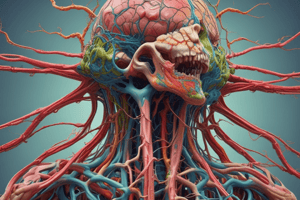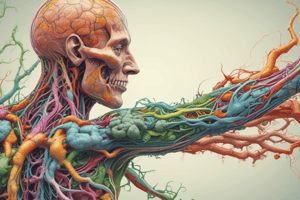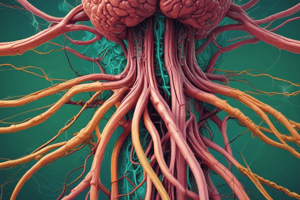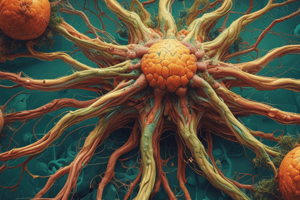Podcast
Questions and Answers
Which system is especially concentrated in the lymphatic system?
Which system is especially concentrated in the lymphatic system?
- Endocrine system
- Digestive system
- Immune system (correct)
- Nervous system
What is one of the functions of the lymphatic system?
What is one of the functions of the lymphatic system?
- Filtering waste from the kidneys
- Pumping blood throughout the body
- Producing digestive enzymes
- Returning fluid to the bloodstream (correct)
What type of vessels recover fluid in the lymphatic system?
What type of vessels recover fluid in the lymphatic system?
- Artery-like vessels
- Nerve-like vessels
- Vein-like vessels (correct)
- Capillary-like vessels
What is a key function of the lymphatic system related to body defense?
What is a key function of the lymphatic system related to body defense?
The lymphatic system helps transport fluids back to the...
The lymphatic system helps transport fluids back to the...
What roles does the lymphatic system play in the body?
What roles does the lymphatic system play in the body?
What is the role of the lymphatic system in the intestinal villi?
What is the role of the lymphatic system in the intestinal villi?
What is one of the key components of the lymphatic system?
What is one of the key components of the lymphatic system?
Lymphoid tissues and which other structure are part of the lymphatic system?
Lymphoid tissues and which other structure are part of the lymphatic system?
What is the fluid carried by lymphatic vessels?
What is the fluid carried by lymphatic vessels?
Lymph moves in which direction?
Lymph moves in which direction?
What mechanism is responsible for lymph movement?
What mechanism is responsible for lymph movement?
The walls of lymphatic vessels contract rhythmically due to smooth muscle? (true or false)
The walls of lymphatic vessels contract rhythmically due to smooth muscle? (true or false)
What is one of the main functions of the lymphatic system?
What is one of the main functions of the lymphatic system?
Aside from maintaining fluid balance, what function does the lymphatic system perform?
Aside from maintaining fluid balance, what function does the lymphatic system perform?
What type of fluid is recovered by the lymphatic system?
What type of fluid is recovered by the lymphatic system?
What happens to lymph after the transport?
What happens to lymph after the transport?
Which cells are part of lymphatic tissues?
Which cells are part of lymphatic tissues?
In lymphatic organs, defense cells are especially what?
In lymphatic organs, defense cells are especially what?
Compared to plasma, how much protein does lymph have?
Compared to plasma, how much protein does lymph have?
Where does extracellular fluid come from to become lymph?
Where does extracellular fluid come from to become lymph?
What is often contained inside the lymphatic capillary?
What is often contained inside the lymphatic capillary?
What is a feature of the capillary wall in lymphatic capillaries?
What is a feature of the capillary wall in lymphatic capillaries?
What do gaps between cells in lymphatic capillaries allow for?
What do gaps between cells in lymphatic capillaries allow for?
When do valve-like flaps of the endothelium open?
When do valve-like flaps of the endothelium open?
What is one layer that composes lymphatic vessels?
What is one layer that composes lymphatic vessels?
The lymphatic vessels converge to larger and larger what?
The lymphatic vessels converge to larger and larger what?
Lymph flows under forces similar to...
Lymph flows under forces similar to...
What is one thing that aids lymph flow?
What is one thing that aids lymph flow?
What cells are part of lymphatic cells?
What cells are part of lymphatic cells?
Which of the following describes natural killer cells?
Which of the following describes natural killer cells?
What cells develop from monocytes?
What cells develop from monocytes?
What is the function of the dendritic cells
What is the function of the dendritic cells
Lymphocytes are scattered in which type of lymphatic tissue?
Lymphocytes are scattered in which type of lymphatic tissue?
Which structure has a connective tissue capsule?
Which structure has a connective tissue capsule?
What is one of the main functions of the red bone marrow?
What is one of the main functions of the red bone marrow?
The medulla populated by?
The medulla populated by?
What fluid is removed by lymph nodes?
What fluid is removed by lymph nodes?
Flashcards
Immune System
Immune System
A cell population that inhabits all organs and defends the body from disease agents.
Lymphatic System
Lymphatic System
A network of organs and vein-like vessels that recover fluid, inspect it for disease agents, activate immune responses, and returns fluid to the bloodstream
Lymph
Lymph
Excess tissue fluid carried by lymphatic vessels.
Lymphatic System Components
Lymphatic System Components
Signup and view all the flashcards
Functions of the Lymphatic System
Functions of the Lymphatic System
Signup and view all the flashcards
Lymphatic System Flow
Lymphatic System Flow
Signup and view all the flashcards
Lymphatic Trunks
Lymphatic Trunks
Signup and view all the flashcards
Right Lymphatic Duct
Right Lymphatic Duct
Signup and view all the flashcards
Thoracic Duct
Thoracic Duct
Signup and view all the flashcards
Lymph Fluid
Lymph Fluid
Signup and view all the flashcards
Lymphatic Capillaries
Lymphatic Capillaries
Signup and view all the flashcards
Lymph Flow Mechanism
Lymph Flow Mechanism
Signup and view all the flashcards
Natural Killer (NK) Cells
Natural Killer (NK) Cells
Signup and view all the flashcards
T Lymphocytes (T Cells)
T Lymphocytes (T Cells)
Signup and view all the flashcards
B Lymphocytes (B Cells)
B Lymphocytes (B Cells)
Signup and view all the flashcards
Macrophages
Macrophages
Signup and view all the flashcards
Dendritic Cells
Dendritic Cells
Signup and view all the flashcards
Reticular Cells
Reticular Cells
Signup and view all the flashcards
Lymphatic (lymphoid) Tissue
Lymphatic (lymphoid) Tissue
Signup and view all the flashcards
Diffuse Lymphatic Tissue
Diffuse Lymphatic Tissue
Signup and view all the flashcards
Lymphatic Nodules
Lymphatic Nodules
Signup and view all the flashcards
Peyer Patches
Peyer Patches
Signup and view all the flashcards
Lymphatic Organs
Lymphatic Organs
Signup and view all the flashcards
Primary Lymphatic Organs
Primary Lymphatic Organs
Signup and view all the flashcards
Organs T and B-cells become immunocompetent
Organs T and B-cells become immunocompetent
Signup and view all the flashcards
Secondary Lymphatic Organs
Secondary Lymphatic Organs
Signup and view all the flashcards
Red Bone Marrow Function
Red Bone Marrow Function
Signup and view all the flashcards
Thymus
Thymus
Signup and view all the flashcards
Thymus Structure
Thymus Structure
Signup and view all the flashcards
Reticular Epithelial Cells
Reticular Epithelial Cells
Signup and view all the flashcards
Lymph Nodes
Lymph Nodes
Signup and view all the flashcards
Lymph nodes Structure
Lymph nodes Structure
Signup and view all the flashcards
Germinal Centers
Germinal Centers
Signup and view all the flashcards
Cervical Lymph Nodes
Cervical Lymph Nodes
Signup and view all the flashcards
Axillary Lymph Nodes
Axillary Lymph Nodes
Signup and view all the flashcards
Thoracic Lymph Nodes
Thoracic Lymph Nodes
Signup and view all the flashcards
Abdominal Lymph Nodes
Abdominal Lymph Nodes
Signup and view all the flashcards
Intestinal and Mesenteric Lymph Nodes
Intestinal and Mesenteric Lymph Nodes
Signup and view all the flashcards
Inguinal Lymph Nodes
Inguinal Lymph Nodes
Signup and view all the flashcards
Popliteal Lymph Nodes
Popliteal Lymph Nodes
Signup and view all the flashcards
Lymphadenitis
Lymphadenitis
Signup and view all the flashcards
Tonsils
Tonsils
Signup and view all the flashcards
Study Notes
- The body contains ten times more bacterial cells than human cells
- Some bacteria are beneficial, and some cause disease
- The immune system is a cell population that protects the body from disease agents
- The lymphatic system is a true organ system of network of organs and vein-like vessels that recover fluid
Lymphatic System Functions
- Includes the network of organs and vein-like vessels that recover fluid
- Inspects it for disease agents
- Activates immune responses
- Returns fluid to the bloodstream
Expected Learning Outcomes
- List the functions of the lymphatic system
- Explain how lymph forms and returns to the bloodstream
- Name the major cells of the lymphatic system and state their functions
- Name and describe the types of lymphatic tissue
- Describe the structure and function of the red bone marrow, thymus, lymph nodes, tonsils, and spleen
The Lymphatic System
- Composed of lymphatic vessels and lymphoid tissues and organs
- Transports fluids back to the blood
- Plays roles in body defense and resistance to disease
- Absorbs digested fat at the intestinal villi
Lymphatic Characteristics
- Lymph is excess tissue fluid carried by lymphatic vessels
- One way system toward the heart
- No pump exists in the lymphatic system
- Lymph moves toward the heart by milking action of skeletal muscle
- Lymph moves toward the heart by Rhythmic contraction of smooth muscle in vessel walls
- Main functions are to maintain fluid balance and protect body from infection and disease
Lymphatic System Components
- The recovered fluid
- Transports the recovered fluid
- Lymphatic tissues are composed of lymphocytes and macrophages
- Lymphatic tissues are aggregates of lymphocytes and macrophages that populate many organs in the body
- Defense cells are concentrated in lymphatic organs
- Lymphatic organs are separated from surrounding organs by connective tissue capsules
- Lymph is clear, colorless fluid, similar to plasma, but with less protein
- Lymph originates as extracellular fluid drawn into lymphatic capillaries
- Chemical composition varies in different places such as the intestines and lymph nodes
- Lymphatic capillaries (terminal lymphatics) penetrate nearly every tissue of the body
- Absent from the central nervous system, cartilage, cornea, bone, and bone marrow
- Capillary wall is endothelial cells overlapping each other like roof shingles
- The lymphatic capillaries are closed at one end
- Cells tethered by protein filaments
- Gaps between cells are large enough for bacteria and cells to enter
- Endothelium creates valve-like flaps that open when interstitial fluid pressure is high, and close when it is low
- Larger vessels composed of three layers
Layers of Lymphatic Vessels
- Tunica interna: endothelium and valves
- Tunica media: elastic fibers, smooth muscle
- Tunica externa: thin outer layer
- Vessels converge into larger vessels
- Collecting vessels course through many lymph nodes
Lymphatic Trunks
- Six lymphatic trunks drain major portions of the body
- Jugular, subclavian, bronchomediastinal, intercostal, intestinal (unpaired), lumbar trunks
Collecting Ducts
- Right lymphatic duct receives lymph from right arm and right side of head/thorax, and empties into right subclavian vein
- Thoracic duct is larger, begins as cisterna chyli, receives lymph from below the diaphragm, left arm, left side of head, neck, and thorax and empties into left subclavian vein
- Subclavian veins collect from thoracic duct
Lymph Flow
- Lymph flows under forces similar to venous return (except heart)
- Lymph flows at low pressure and slower speed than venous blood
- Lymph is moved along by rhythmic contractions of lymphatic vessels
- Stretching of vessels stimulates contraction
- Flow aided by skeletal muscle pump
- Arterial pulsation rhythmically squeezes lymphatic vessels
- Thoracic pump aids flow from abdominal to thoracic cavity
- Valves prevent backward flow
- Rapidly flowing blood in subclavian veins, draws lymph into it
- Exercise increases lymphatic return
Lymphatic Cells
- Natural killer (NK) cells are large lymphocytes that attack/destroy bacteria, transplanted tissue, host cells infected with viruses/cancer
- T lymphocytes (T cells) mature in thymus
- B lymphocytes (B cells) activation causes proliferation and differentiation into plasma cells that produce antibodies
- Macrophages are avidly phagocytic cells of connective tissue, develop from monocytes, phagocytize tissue debris, dead neutrophils, bacteria, and foreign matter
- Macrophages process foreign matter, display antigenic fragments to certain T cells alerting immune system
- Antigen-presenting cells APCs
- Dendritic cells are branched, mobile APCs in epidermis, mucous membranes, and lymphatic organs
- Dendritic cells alert immune system to pathogens that breached body surface
- Reticular cells are branched stationary cells that contribute to stroma of lymphatic organ
Lymphatic Tissue
- Lymphatic (lymphoid) tissue—aggregations of lymphocytes in the connective tissues of mucous membranes and various organs
- Diffuse lymphatic tissue is the simplest form
- Lymphocytes are scattered (not clustered)
- Prevalent in body passages open to the exterior like respiratory, digestive, urinary, and reproductive tracts
- Mucosa-associated lymphatic tissue (MALT)
- Lymphatic nodules (follicles) are dense masses of lymphocytes and macrophages that congregate in response to pathogens
- Constant feature of the lymph nodes, tonsils, and appendix
- Peyer patches: dense clusters in the ileum, the distal portion of the small intestine
Lymphatic Organs
- Lymphatic organs are anatomically well-defined
- Have connective tissue capsule that separates lymphatic tissue from neighboring tissues
- Primary lymphatic organs: red bone marrow and thymus
- Site where T and B cells become immunocompetent and recognize/respond to antigens
- Secondary lymphatic organs: lymph nodes, tonsils, and spleen
- Immunocompetent cells populate these tissues
Red Bone Marrow
- Red bone marrow is involved in hemopoiesis (blood formation) and immunity
- It is soft, loosely organized, highly vascular material
- Separated from osseous tissue by endosteum of bone
- Blood cells mature, they push thru reticular/endothelial cells to enter the sinus and flow away in bloodstream
Thymus
- Part of the endocrine, lymphatic, and immune systems
- Houses developing lymphocytes
- Secretes hormones regulating activity
- Bilobed organ in superior mediastinum between sternum and aortic arch
- Undergoes degeneration (involution) with age
- Fibrous capsule gives off trabeculae (septa) that divide the gland into several lobes
- Lobes have cortex and medulla populated by T lymphocytes
- Reticular epithelial cells seal off cortex from medulla, forming blood–thymus barrier
- Signaling molecules produced are thymosin, thymopoietin, thymulin, interleukins, and interferon
Lymph Nodes
- Lymph nodes are the numerous lymphatic organs
- About 450 in typical young adult
- Serves two functions of cleansing lymph and Act as a site of T and B cell activation
- Elongated, bean-shaped structure with hilum
- Enclosed with fibrous capsule with trabeculae that divide interior into compartments
- Stroma of reticular fibers and reticular cells
- Parenchyma divided into cortex and medulla
- Germinal centers are where B cells multiply and differentiate into plasma cells
- Afferent lymphatic vessels lead into node along convex surface
- Lymph leaves the node through one to three efferent lymphatic vessels that leave the hilum
Lymph Node Types
- Cervical lymph nodes consist of deep/superficial groups in the neck; monitor lymph coming from head/neck
- Axillary lymph nodes are concentrated in armpit
- Axillary lymph nodes receive lymph from upper limb and female breast
- Thoracic lymph nodes are in thoracic cavity, embedded in mediastinum; receive lymph from mediastinum, lungs, and airway
- Abdominal lymph nodes occur in posterior abdominopelvic wall and monitor lymph from the urinary/reproductive systems
- Intestinal and mesenteric lymph nodes are found in mesenteries, adjacent to appendix/intestines; monitor lymph from digestive tract
- Inguinal lymph nodes are in groin and receive lymph from the entire lower limb
- Popliteal lymph nodes occur on back of knee and receive lymph from the leg proper
- With lymphadenitis, a lymph node is swollen and painful due to a foreign antigen challenging the node
- Lymphadenopathy is the collective term for all lymph node diseases
- With metastasis, cancerous cells break free from original tumor travel to other sites in body, and form new tumors
- Metastasizing cells enter lymphatic vessels
- Metastasizing cells tend to lodge in first lymph node encountered and will multiply/destroy the node
- Swollen, firm, and usually painless upon lodging
- Tends to spread to next node downstream
- Treatment of breast cancer involves lumpectomy, mastectomy, along with removal of nearby axillary nodes
Tonsils
- Patches of lymphatic tissue located at entrance to the pharynx
- Guards against ingested/inhaled pathogens
- Covered with epithelium
- Deep pits: tonsillar crypts are lined with lymphatic nodules
- Tonsillitis is inflammation of the tonsils
- Tonsillectomyis removing the tonsils
Three main sets of tonsils
- Palatine tonsils - pair at posterior margin of oral cavity/ most often infected
- Lingual tonsils - pair at root of tongue
- Pharyngeal tonsil (adenoids) - single tonsil on wall of nasopharynx
- All tonsils are covered by epithelium
- Pathogens get into tonsillar crypts and encounter lymphocytes
Spleen
- Parenchyma exhibits two types of tissue
- Red pulp: sinuses filled with erythrocytes
- White pulp: lymphocytes and macrophages surrounding small branches of splenic artery
- It is the body’s largest lymphatic organ
Spleen Functions
- Healthy red blood cells (RBCs) pass through
- Designated the "erythrocyte graveyard" for old, fragile RBCs
- Blood cell production in the fetus and anemic adults
- Monitors blood for foreign antigens and keeps an army of monocytes for release when needed
- Stabilizes blood volume through plasma transfers to lymphatic system
- Spleen is highly vascular and vulnerable to trauma/infection
- Ruptured spleen often requires splenectomy, resulting in person susceptible to future infections, premature death
Studying That Suits You
Use AI to generate personalized quizzes and flashcards to suit your learning preferences.




